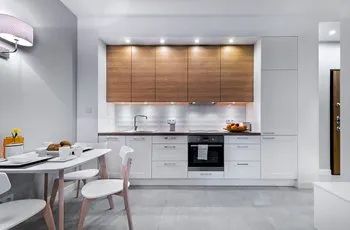1. Prioritize Task Lighting
While kitchens play a variety of roles for a family, few activities require the level of focused attention as cooking. Cutting food, measuring ingredients, and reading cookbooks become challenging when undertaken in poor light. Your first goal in redesigning your kitchen lighting should be to make tasks like these as easy and well-lit as possible with task lights.
Task lights yield the best results when placed at a height somewhere between your head and the work surface. Overhead lights, by contrast, often throw frustrating shadows over your workspace. For best results, consider installing task lights along the underside of kitchen cabinets above your most-used food prep areas.
LED lights offer excellent results when used as under-cabinet lights. Not only do LEDs come in a versatile range of shapes, but they also consume very little energy. Linear LED strips provide a bright, even source of light. Depending on the placement of your work area, you may choose to have LED lights hardwired into your home's electrical supply, or you can power them using plug-ins or batteries.
2. Recess Your Ceiling Lights
Traditionally, most kitchens have ceiling lights. Unfortunately, ceiling lights tend to create glares on countertops. Depending on where you stand in the room, overhead lighting can also create shadows that make it difficult to see and work clearly. For these reasons, current design trends emphasize incorporating more indirect light sources.
Nonetheless, ceiling lights still have their place in the kitchen, thanks to their ability to throw light over a wide area. Fortunately, you can reduce unwanted problems like glare and shadow by switching over to recessed ceiling lights. Be aware, however, that recessed lights must be placed very carefully to yield the optimal results.
When placed correctly, recessed lights can not only provide good general lighting but can also be used for more intensive tasks. You should place recessed lights so that they lie directly above the edge of your kitchen's counter - in other words, about 24 inches from the wall. This location provides excellent work surface lighting while minimizing the chances that your body will create shadows.
3. Incorporate Dimmer Switches
Ambient lighting is also important in kitchens. After all, only a fraction of the time you spend in the kitchen goes to high-intensity cooking tasks. At other times, warmer and less harsh lighting options can create a more inviting and relaxing atmosphere.
You should certainly consider installing wall sconces and other indirect and ambient light sources. Yet you can also diversify your existing lighting options by adding dimmer switches to your kitchen. Dimmer switches come in a variety of types, from rotary switches to toggle switches to sliders.
Try out each of the different styles and pick the one that suits you best. Just be sure to find a model compatible with the bulbs used in your kitchen. The best dimmers can be used for both CFL and LED bulbs.
Homeowners looking for a simple kitchen remodeling project can upgrade their lighting setup for a fraction of the normal remodeling cost. For more information about this and other kitchen remodeling projects, please
contact the pros at JO Contractors.

